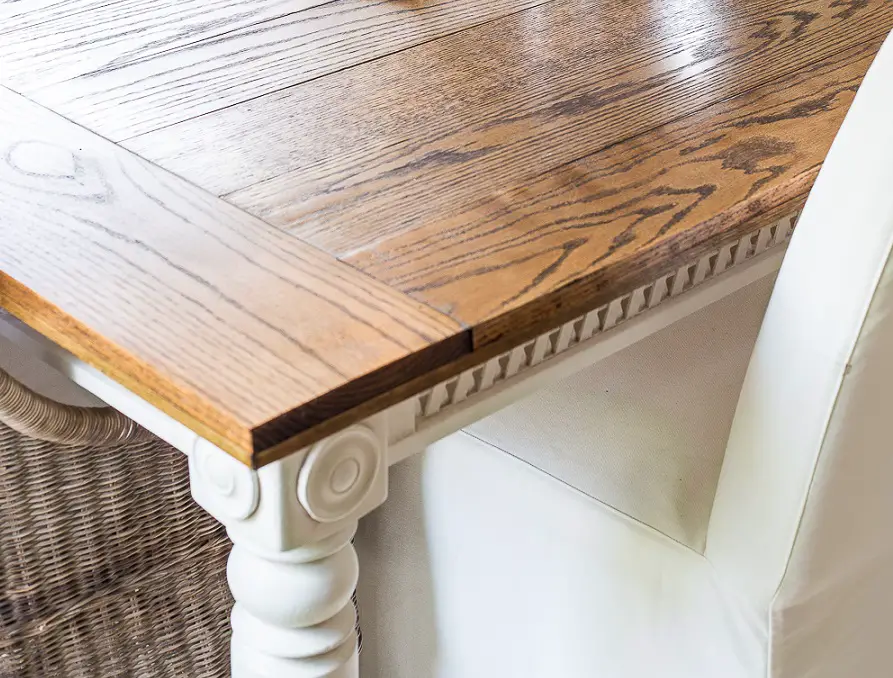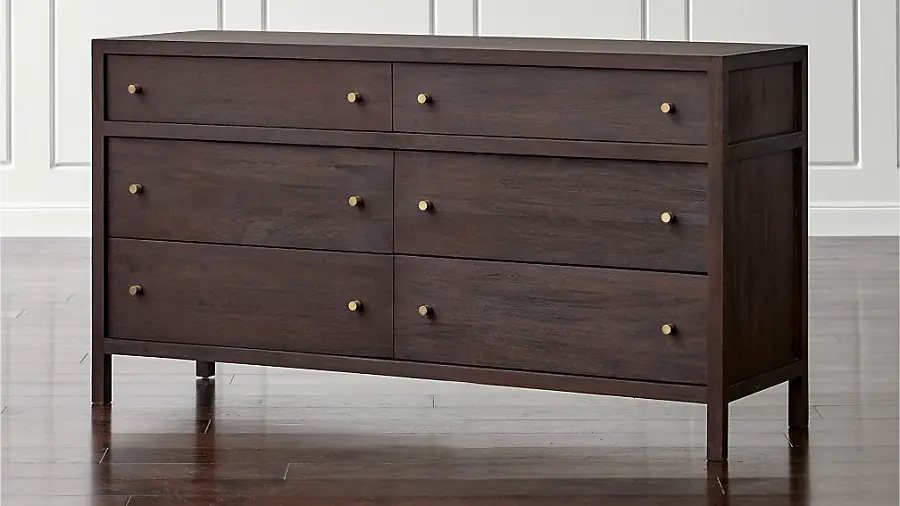I understand from your questions that there is some confusion about these materials and their role in coating wood. The difference between varnish and paint primarily means the difference between seeing or not seeing the natural design of wood. Sometimes knowing some things well doesn't make you a good teacher. Being terms that I am very used to I forget that not everyone knows what they mean and I don't explain elementary things. I am trying to rectify the mistake now, and those for whom these things are already understood I ask to be understanding. We get to more complicated things. 🙂
Do we want to see the natural wood grain or not?
That's what the difference between varnish and paint comes down to. If we want to see the grain of the wood, its natural design, and we want it to be protected against scratches, dents, stains, then we use varnish. If, on the contrary, we want to cover the wood, then paint is used. In other words, you can see the wood with varnish, but not with paint.
Why cover wood? Because not all wood is oak or nuc and some wooden elements have stains, stains, knots or other flaws we want to cover up. Or because we simply like colorful furniture. When the wood is painted, the effect is not the same as painting a MDF panel or a piece of plastic or sheet metal. The wood absorbs the paint, and the result is not a totally smooth surface. The wood's design continues to show through under the layer of paint, and if materials that mark pores or emphasize the design - such as skates - then the effect is very interesting. So we should not start from the idea that if you love wood, you don't have to hide it. It's still there and sometimes its value is even increased by painting.
So varnish is used when you want to show the wood grain and its natural design, and paint is used when you want the surface to be opaque and its design to be invisible.

We can color wood without covering the grain
Someone asked me how wood can be both colored and transparent. It's possible if the coloring is done with the berries that are solutions based on soluble dyes. They dissolve in water or organic solvents and color the wood fiber in depth, without covering the design, as in the case of paints. It is the same as coloring cotton or wool yarn.
After staining, the design of the wood will be further emphasized by the differential absorption of the stain. Some people do not like color differences on the wood surface and want a very uniform stain. Uniformity usually comes at the risk of loss of transparency. By using less transparent staining materials we get a uniform coloration, but the wood grain is no longer as visible. I'm not saying it's bad or it's good. Everyone sees "beautiful" in their own way. I just want you to know that a living material like wood cannot be perfectly uniform and expressive.
After staining and drying the varnish is applied and the resulting finish will be perfectly transparent, but colored as you wish: walnut, oak, cherry, mahogany, rosewood, etc.
Primer has nothing to do with transparency. It is not similar to the one applied to the board on the house
The background was also subject of an article in which I told you why it is necessary. The fact that the name is similar to the product used to protect the board from rusting before applying paint leads many to think of a colored product.
Wood primers can be transparent or colored and are used as an intermediate layer(s) between the wood (colored or not) and the final coat of varnish or paint. It is used because it has certain qualities that make furniture or finished objects look better.
All in all, a clear finish cycle consists of a clear finish (only if you want the fiber to be colored), clear primer and varnish. And an opaque finish, colored primer and paint. The primer is only dispensed with if the lacquer has the varnish and primer. There are such products, especially DIY ones. In this case the coat of primer is replaced by a coat of varnish (2-3 successive coats of varnish are applied).
In all these cycles, other materials (impregnating agents, insulating agents, patinas) may also be involved, which impart certain properties or effects to the finish.

When and why to varnish over paint
Paint, like varnish, has surface properties: scratch and impact resistance, stain resistance, pleasant stain. This is why it is considered the final coat and does not need to be covered with any other material.
There are, however, situations where it may be advisable to apply a coat of varnish on top of the paint. This is generally done when there is a high risk of scratching the paint. By applying a coat of varnish on top, even if it does get scratched, it is less noticeable and the paint layer remains intact.
Another reason for applying lacquer over paint is to give depth to the finish. It is used for high gloss products (high gloss). When 1-2 coats of gloss varnish are applied over the paint, the gloss of the film is more beautiful and deeper.
I hope I have been more explicit this time. If I have failed or you think you need more information, please leave your comments and questions below in the dedicated space. However, if you think it is clear enough to make it clear to others, feel free to share it.



































Good evening. After reading the above lines more light came into my head. I understood the role of the bath, I was going to ask you about the role of the varnish after painting, got it. The only nebula remains the primer. I'll take a general example: if I have some planks that I want to make some polishes out of in my pantry, after me, I take a can of paint, paint them and that's it. In which situations do I use primer first? Isn't painting directly on the wood enough? Thank you very much for your articles.
Good evening.
It is also possible without primer. I've also written that, for DIY projects, you don't need to do it the factory way. Factory finishing is much more demanding, with more steps and products that increase the final quality of the film. Primer is a material that has better adhesion to wood, higher body (resin that remains on the wood after solvent evaporation), grinds better. For a film to look very good and be very pleasant to the touch it needs 2-3 intermediate sandings. This is made possible by applying primer. Basically, a coat of primer is applied over the bait, allowed to dry, then sanded, dusted and the next coat applied. If the primer were not thick enough there would be nothing left on the board and if it were not sanded smoothly, it would not give a very pleasant surface. After a smooth and beautiful surface has been achieved, the final coat of varnish is applied, which has superficial properties, does not scratch, is resistant to knocks, does not stain, has a pleasant feel, may or may not have a gloss, etc.
DIY projects don't need to be factory perfect. Plus, products are made to be easier to use. There is no need for so many intermediate operations and so many products. In your case it is enough to give 2-3 coats of paint without any other materials.
I hope I didn't get lost in the details again or use terms that are impossible to understand. 🙂
All the best!
Thank you very much. You have such a clear and to the point style of explaining that I don't think there is anyone who, after reading your articles, does not understand, my opinion.
Thank you too!
I have used on various occasions for wood used outside or inside, a colorless primer from DUFA, many years ago, I do not know if it still exists or what its substitute is, but its properties, apart from the fact that it closed the pores of the wood (so after sanding the wood did not absorb so much colorless varnish, what I used, DYO YAHTMARINE glossy, with 2 coats I had super quality), but the primer also had the treatment of the wood against fungi, woodworm and blue mould .... these have delighted me .... and especially the low consumption of varnish . Did I do the right thing and now when I am going to do some more work I will find the same products or are there similar ones???
Good evening!
Yes, you did well. That's one of the purposes of primer - to close the pores, the varnish consumption is much lower.
You might find the products, but they may not have exactly the same qualities. In the meantime, the law on biocidal products (against fungi, moulds and insects) in varnishes, paints and impregnants has been tightened and many have chosen not to use them. It's best to ask first. There are companies that have 1-2 products for this purpose that they have registered. They recommend applying a coat of protective product after which the primer and varnish finish is applied. But again, I don't know if the products you mentioned have undergone these changes.
All the best!
Hello,
The window sills are pine and are painted some color and it's been applied for a long time so it occurred to me to fix this situation this way:
1. remove the paint with the hot air blower;
2. I'll grind with 80 then 120 or 150;
3. apply SAVANA water-based colourless primer
4. varnish with .... water-based SAVANA
The order, to me who knows nothing practical about such things, seems good and reasonable. What I don't know is if I should put 220 smilgher or something between primer and varnish and if I should leave the varnish colourless so that the fibre shows or if I should give it coloured?
The heels have another problem, which I need to solve first, namely some gaps through it and I want to know how and with what to solve the situation? Probably some putty or something.
Thanks a lot and have a great day!
Hello.
You guessed right, even though you say you have no practical experience at all. That makes me think you will definitely succeed. 🙂
A recommendation: remove the old lake very well. Any traces of old varnish/paint will cause the new finish to have problems in the future. The old coat will peel off with the new one.
The paint is more durable than the varnish because it doesn't let the sun's rays through. The varnish must be for outdoors because otherwise it is not resistant. Outdoor varnishes contain a small amount of pigments that sit in the path of sunlight and repel it. That's why outdoor varnishes are not totally colourless, nor perfectly transparent. But they have the advantage that the wood is visible.
For grouting you can use a putty made of outdoor acrylic glue (D3 or D4) and fine wood powder or you can buy outdoor resistant wood putty. After grouting sand the surface and apply the finish.
Good luck!
Hello,
AM a concrete staircase and the steps are clad in beech wood. The wood has been varnished ( 2 coats ) . my question is: could I paint over the varnish? Or do I have to sand the existing varnish?
Hello!
Sanding is necessary for adhesion. If it is not done the coat of paint you put on top can peel off, especially if the varnish is a harder, two-component varnish (as I suspect the one applied to the beech steps is). Sanding is even more necessary when using a water-based paint. If for some reason (knocks, scratches) the paint coat comes off in one corner it will peel like a skin if sanding was not done before application.
The only variants where sanding is not recommended is when the varnish has been nitrocellulose and a nitro paint is applied on top or in the case of chalky paints. Neither situation applies to you. Nitro varnish is a soft varnish and not recommended for traffic, so I don't think your steps are done with such a varnish. Chalky paints are flaky and also not recommended for traffic.
I recommend sanding the steps before applying paint. A little more work, but the result will be much better in time. Sanding does not have to be done with a lot of effort, but a light sanding to create those little curls for the paint to "cling" to. Sand with a fine abrasive sponge or 280 or 320 grit sandpaper.
All the best!
Hello,
I have read with interest your articles, the readers' questions and the answers given but I have not found the answer to one question. I would like to know what is the best, more precisely the most resistant, exterior coating for wood. I don't necessarily care if the wood grain is showing or sanding. More specifically, I am interested in coating a wooden railing on a balcony in a mountain area where the weather is not very friendly. Thank you!
Hello.
The most resistant is the paint, which does not show the natural design of the wood. The next most popular is lacquer (semi-transparent) and the combination of bait and transparent lacquer for the exterior.
Paints come in many varieties. In my opinion the best are oil-based paints (linseed oil).
More about exterior wood finishing can be found in the links below.
All the best!
https://revistadinlemn.ro/2018/08/03/12-reguli-simple-pentru-a-avea-constructii-din-lemn-rezistente-la-exterior/
https://revistadinlemn.ro/2018/06/25/8-cele-mai-frecvente-intrebari-despre-protejarea-lemnului-la-exterior/
Thanks a lot for the advice!
Hello,
Please guide me on how to proceed with the refurbishment of an oak veneered bookcase whose varnish has deteriorated in some areas.
What are the steps to follow and what products do you recommend.
Thank you for your kindness.
Hello!
It depends on how much damage to the lake and how big you want the change to be. If the lake has superficial scratches and patches, the veneer has not been reached so that it is also affected (discolouration, darkening, swelling), wash the library with water and dishwashing detergent or soap (wipe with a well wrung out cloth), wipe well afterwards and leave to stir. This degreasing has to be done because over time all kinds of impurities and greasy substances or waxes (from Pronto jam cleaning products) settle. Then sand lightly with 280 or 320 grit sandpaper or fine abrasive sponges and apply 1-2 coats of water-based varnish. If you want to change the look, you can use a water-based paint in the desired colour instead. Apply at least 2 coats for good coverage. There is also the possibility to obtain special effects (shabby chic or antique look), but it is a lot of work.
If scratches have reached the veneer and damaged it, the varnish should be removed by sanding or using a paint stripper. Then repair the veneer and apply varnish (2-3 coats) as above. If the veneer is badly stained, one solution may be to change the appearance of the bookcase with paint. It is less work.
You can also find useful information in the links below.
All the best!
https://revistadinlemn.ro/2017/05/17/cum-pot-fi-reparate-zgarieturile-de-pe-mobila/
https://revistadinlemn.ro/2018/09/19/cum-poti-reconditiona-mobila-lacuita-cu-zgarieturi-adanci-sau-lovituri/
https://revistadinlemn.ro/2018/03/07/3-situatii-cand-lemnul-arata-mai-bine-vopsit/
https://revistadinlemn.ro/2018/02/21/transformarea-mobilei-cu-vopsea-pe-baza-de-apa-annie-sloan-chalk-paint/
Thanks for the advice.
Hello,
I would like to ask you to advise me with what product I can increase the gloss of a wooden table, which has already been painted white?
The table is very massive, it's inside the house, it has recently been repainted semi-matt, and I would like to lacquer it in position.
Thanks in advance
Hello!
To keep the same degree of whiteness you should use a very glossy white paint, of the same nature as the semi-matt one. You must use the same type of paint to avoid incompatibilities between the two materials. Apply with a brush, carefully and let it dry for a longer period (min 24 hours) trying to protect it from dust. Dust is the enemy of gloss.
Another solution would be to polish the existing tabletop. You will need a rotary grinder or a boring machine, grinding discs and a 2000 or 3000 grit abrasive solution. You can go from 35 to 45 degrees of gloss, which is the same as a semi-finished surface, to 70 or even 80.
More information about polishing can be found in the link below.
All the best!
https://revistadinlemn.ro/2017/07/26/ce-este-polisarea-de-ce-este-nevoie/
Hello, I have some solid wood doors that have been varnished approx. 16 years, is there any chance I can paint them?
Hello!
You can dye them. I understand you want to apply the paint over the old varnish. You must first wash them to degrease them (with water and detergent), wipe them off and let them rinse. To avoid compatibility problems I recommend using water-based paints (they are compatible with most types of varnishes and paints). The surface must be sanded beforehand (fine abrasive sponge) for the paint to adhere. It is also possible without sanding if you use Annie Sloan type chalky paints. The paint must be fixed with wax or varnish at the end because otherwise it will not hold.
All the best!
Hello.
First of all very good job with the explanation, it is very easy to understand which was exactly what I needed.
But now my question is, if I want to stain a wood, but on the transparent pattern.
How to choose the right colour?
Case 1: coloured bath > clear varnish
Case 2: clear varnish > coloured varnish
Case 3: coloured bath > coloured varnish
Thank you.
Good evening!
There are 2 variants:
- if the wood is dense and evenly stained (oak, cherry, ash), use a soluble stain-based stain that will stain the transparent wood, bringing out its natural pattern very well. After drying, apply clear varnish.
- if the wood is softer and the absorption inside is differentiated (poplar, lime, spruce), use a stain based on pigments that are semi-transparent and even out the differences that occur because the wood absorbs differently. After drying, apply clear varnish.
Coloured varnish is used to repair some staining defects. Applying it evens out the final appearance, but the risk is that the natural beauty of the wood is lost and it takes on a more plastic-like appearance. Wood is special precisely because it has personality, and staining makes this personality visible.
All the best!
Hello, I have a question for you, I would like to know what kind of water-based varnish, primer, varnish you recommend for some beech wood steps? I would like something semi-professional or professional that can be applied both with a brush/sponge and with a paint gun. Or, can the quality and appearance of the steps be affected by using these products instead of DYI ones assuming all other processes have been followed (i.e. wetting, sanding and raw and after bathing) thank you in advance for your reply.
Hello!
You can use water-based floor varnishes. You have the link below to one such product. It can be applied with a trowel or spray gun. Being stairs, you need a smaller, narrower trowel. Find something like this in DIY stores.
Professional products have superior qualities to DIY products. If applied according to instructions, they have better strengths and last longer. However, correct application plays a very important role.
All the best!
https://iscusit.market/product-category/finisare-lemn/lac-lemn-interior/
Good evening, I discovered your website and find it very informative. I have a table top that I wanted to make black, but have the fiber show through the color. I chose a solvent and silicone based grout, I couldn't find black so I got a very dark wenge. Then varnish. Only now it's lighter and doesn't really fit in the context of the room (black/white furniture and walls). What do you guys advise me to do? (I've already invested a lot of time and would like a quick and efficient but good looking solution, if any)
Hello!
Thanks for your appreciation!
Anything you can do quickly to close the color will make the fiber less visible. You can apply one more coat of colored varnish with black baikat. Depending on the type of varnish used (solvent or water), add up to 10% black (plain, no added resins) solvent/water based varnish. For a uniform appearance use a small, special paint applicator. If the lacquer is solvent-based, the sponge on the roller of the squeegee must be solvent resistant.
Another option is a thin coat of black paint as thin as possible. Use the same type of paint as the varnish to be compatible. Apply it all with a brush.
If you stick to the idea of seeing the fiber, you will need to remove the varnish by stripping (I leave a link below) or sanding and apply a darker varnish. After drying, apply colorless varnish. Be careful, clear lacquer "brightens", it opens the color.
Good luck!
https://www.youtube.com/watch?v=KOSeHBkhiEw